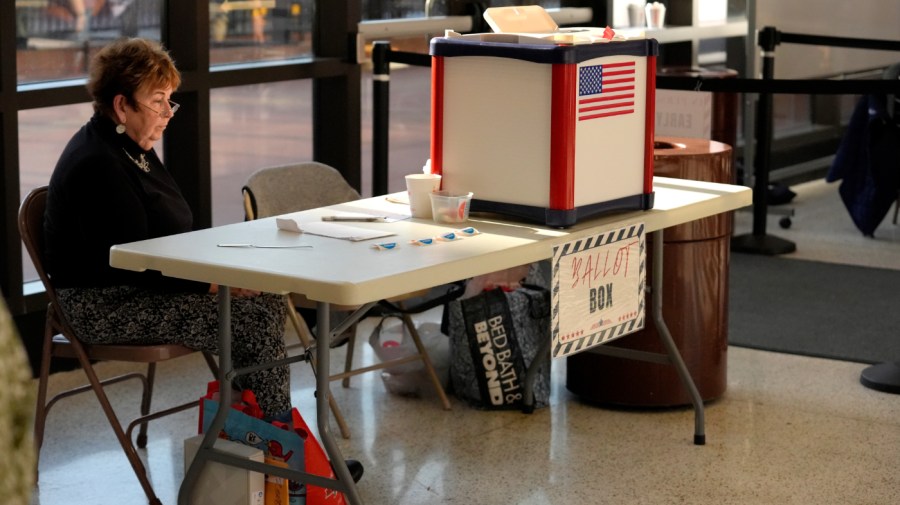On the eve of election day, polls continue to show a tight race atop the ticket, with Vice President Kamala Harris and former President Donald Trump virtually deadlocked.
This is particularly true on the national level, where the New York Times polling aggregate shows Harris with a 1-point (49 percent to 48 percent) lead – an effective tie.
Within swing states, the situation is much the same.
The Times swing state aggregate shows Trump leading in five states – Nevada, North Carolina, Pennsylvania, Arizona and Georgia — to Harris’s two — Wisconsin and Michigan — although in all states, the leads are within the margin of error.
That said, if last week it appeared that Trump had the momentum, individual polls in the election’s closing days at least present countervailing evidence.
The last Marist polls give Harris slight leads in the “Blue Wall” states: Michigan (+3 points), Pennsylvania and Wisconsin (+2 points each).
In that same vein, CNN’s “Poll of Polls” in those states shows Harris with 3-point leads in both Michigan and Wisconsin (49 percent to 46 percent) each, with a tie in Pennsylvania (48 percent to 48 percent).
While the polls show that the race remains extremely close, there are reasons to believe that Harris may have regained some of the momentum she had late this summer.
There is the fallout from anti-Puerto Rican comments made by a speaker at Trump’s Madison Square Garden rally, a push by the Harris campaign to appeal to male voters and close the gender gap, and Trump’s failure to use Nikki Haley as a surrogate with both female voters and moderate Republicans.
The presidential betting odds, while still in Trump’s favor, confirm a slight change in momentum. After peaking at 64 percent to 35 percent in favor of Trump, they now sit at 60 percent-38 percent, per RealClearPolitics tracker.
As we’ve previously written here, looking below the topline numbers and toward voters’ perceptions of the candidates on the issues as well as demographic shifts is increasingly valuable in a close election.
Trump is still leading on key issues such as trust to handle the economy, although his 7-point advantage (52 percent to 45 percent), has been cut roughly in half from last month, per New York Times polling.
Conversely, Harris is underperforming among key demographics such as voters of color, and specifically Hispanic men and Black men, although she still has comfortable leads with all. It also remains to be seen how the anti-Puerto Rican comments hurt Trump, as well as the impact of Harris’ push to target Black men.
Additionally, Harris’ 6-point advantage (47 percent to 41 percent) with suburban voters may make up for her underperformance among men generally, and Hispanic and Black men more specifically.
Early voting data also provide some insights. Republicans are voting early at considerably higher rates than in 2020 — Democrats have just a 3 percent advantage, per the University of Florida Election Lab, compared to a 14 percent lead four years ago.
However, in the battleground states, women make up 55 percent of early voters. Given Harris’ advantage with women, this may prove key.
And as early voting data from Pennsylvania show that among older voters — a critical bloc for Trump — Democrats make up 58 percent of early voters, compared to just 35 percent for Republicans.
It is important to add that, as in any presidential election, this race is about more than who wins the White House. Control of both the Senate and the House of Representatives is up for grabs.
For either Trump or Harris, these congressional races will significantly affect their ability to push forward their respective agendas.
It appears increasingly probable that Republicans will flip the Senate, likely winning 51 or 52 seats. The GOP is virtually certain to flip Montana and West Virginia, where Republican candidates are running well ahead of their Democrat opponents. Further, there is a possibility that Republicans secure wins in Pennsylvania, Wisconsin and Ohio, all swing states with extremely close Senate races.
The House is more likely to turn on what happens in the presidential race. A Trump victory will improve Republicans’ chances of holding on to that chamber, whereas a Harris victory would likely result in Democrats flipping the House.
To be sure, one big advantage for Democrats in terms of the House is the large number of “toss-up” races in deep-blue states such as California and New York.
Indeed, of the 25 House seats considered “toss-ups” by the New York Times, seven of them are in those two states, where Republicans had surged in 2022, helping to flip the House in that year’s midterms.
Democrats are eyeing a number of these — particularly California’s 22nd, 27th, 41st and 45th, and New York’s 17th and 19th — as vulnerable GOP-held seats that could give them a narrow majority in the House.
Ultimately, an unprecedented election cycle comes to a head tomorrow. And while both Harris and Trump have paths to victory, it remains to be seen whether Harris can turn a less-than-great final week for Trump into a victory, or if Trump has done just enough to return to the White House.
Douglas E. Schoen and Carly Cooperman are pollsters and partners with the public opinion company Schoen Cooperman Research based in New York. They are co-authors of the book, “America: Unite or Die.”

